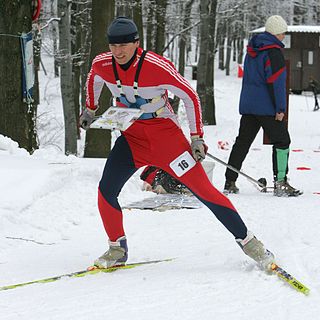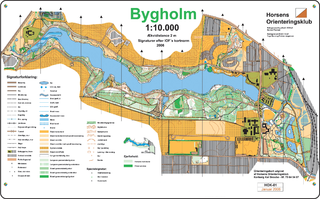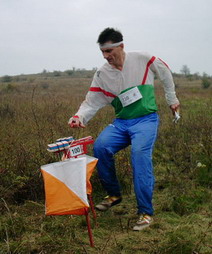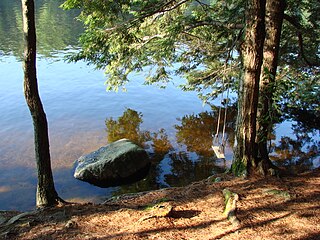
Orienteering is a group of sports that require navigational skills using a map and compass to navigate from point to point in diverse and usually unfamiliar terrain whilst moving at speed. Participants are given a topographical map, usually a specially prepared orienteering map, which they use to find control points. Originally a training exercise in land navigation for military officers, orienteering has developed many variations. Among these, the oldest and the most popular is foot orienteering. For the purposes of this article, foot orienteering serves as a point of departure for discussion of all other variations, but almost any sport that involves racing against a clock and requires navigation with a map is a type of orienteering.

Kayaking is the use of a kayak for moving over water. It is distinguished from canoeing by the sitting position of the paddler and the number of blades on the paddle. A kayak is a low-to-the-water, canoe-like boat in which the paddler sits facing forward, legs in front, using a double-bladed paddle to pull front-to-back on one side and then the other in rotation. Most kayaks have closed decks, although sit-on-top and inflatable kayaks are growing in popularity as well.
Canoe polo, also known as kayak polo, is one of the competitive disciplines of kayaking. The sport is also known simply as "polo" by its players and supporters.

Wildwater canoeing is a competitive discipline of canoeing in which kayaks or canoes are used to negotiate a stretch of river speedily. It is also called "Whitewater racing" or "Downriver racing" to distinguish it from whitewater slalom racing and whitewater rodeo or Freestyle competition.

Canoe slalom is a competitive sport with the aim to navigate a decked canoe or kayak through a course of hanging downstream or upstream gates on river rapids in the fastest time possible. It is one of the two kayak and canoeing disciplines at the Summer Olympics, and is referred to by the International Olympic Committee (IOC) as Canoe/Kayak Slalom. The other Olympic canoeing discipline is canoe sprint. Wildwater canoeing is a non-Olympic paddlesport.

Tubing, also known as inner tubing, bumper tubing, towed tubing, or kite tubing, is a recreational activity where an individual rides on top of an inner tube, either on water, snow, or through the air. The tubes themselves are also known as "donuts" or "biscuits" due to their shape.

A sprint canoe is a canoe used in International Canoe Federation canoe sprint. It is an open boat propelled by one, two or four paddlers from a kneeling position, using single-bladed paddles. The difficulty of balance can depend on how wide or narrow the canoe is, although regularly the less contact a canoe has with the water the faster it goes. This makes the narrower boats much faster and popular when it comes to racing.

Pawtuckaway Lake is a 784-acre (3.17 km2) reservoir in Rockingham County in southeastern New Hampshire, United States, in the town of Nottingham. The lake is located in the Piscataqua River drainage basin.

A canoe livery or canoe rental is a business engaged in the boat livery of canoes or kayaks. It is typically found on or near streams, rivers, or lakes that provide good recreational opportunities. A related but dissimilar business is a boat rental business, which is often distinguished by renting powered or sail craft and by not having a provision for return from a remote location. Such liveries can be found worldwide, wherever there are sufficient tourists or locals to support the activities.

Ski orienteering (SkiO) is a cross-country skiing endurance winter racing sport and one of the four orienteering disciplines recognized by the IOF. A successful ski orienteer combines high physical endurance, strength and excellent technical skiing skills with the ability to navigate and make the best route choices while skiing at a high speed.

An orienteering map is a map specially prepared for use in orienteering events. It is a large-scale topographic map with extra markings to help the participant navigate through the course.

Sprint kayak is a sport held on calm water. The paddler is seated, facing forward, and uses a double-bladed paddle pulling the blade through the water on alternate sides to propel the boat forward. Kayak sprint has been in every summer Olympics since it debuted at the 1936 Summer Olympics. Racing is governed by the International Canoe Federation.

A control point is a marked waypoint used in orienteering and related sports such as rogaining and adventure racing. It is located in the competition area; marked both on an orienteering map and in the terrain, and described on a control description sheet. The control point must be identifiable on the map and on the ground. A control point has three components: a high visibility item, known as a flag or kite; an identifier, known as a control code; and a recording mechanism for contestants to record proof that they visited the control point. The control point is usually temporary, except on a permanent orienteering course.

Pawtuckaway State Park is a 5,000-acre (20 km2) preserve in New Hampshire, United States. It is one of the largest state parks in southeastern New Hampshire and is named for Pawtuckaway Lake and the Pawtuckaway Mountains. The park extends from the west shore of the lake to the west side of the mountains.

Canoe marathon is a paddling sport in which athletes paddle a kayak or canoe over a long distance to the finish line. The International Canoe Federation states the standard distances are at least 10 kilometres (6.2 mi) without an upper limit, while short distance races are between 3.4 kilometres (2.1 mi), and 10 kilometres (6.2 mi). Many events are raced down sections of river, including currents or portages around obstacles. Some events attract thousands of competitors and are staged over several days.
The Ski to Sea Race (S2S), widely known as the Ski to Sea, is a seven-legged, 93-mile (150 km) long, multi-event competition held on the Sunday of Memorial Day weekend in Whatcom County. The race starts on the ski slopes of Mount Baker Ski Area, and ends at Marine Park in Fairhaven, on the shore of Bellingham Bay. The seven legs of the race are: cross-country skiing, downhill skiing or snowboarding, running, road biking, canoeing, cyclo-cross biking, and finally kayaking. The Ski to Sea Race is managed by Whatcom Events, with a race committee that includes a race director, an operations assistant, one or two chairmen to oversee each event, a volunteer coordinator along with nearly 900 volunteers.

The following outline is provided as an overview of canoeing and kayaking:

College club sports in the United States are any sports offered at a university or college in the United States that compete competitively with other universities, or colleges, but are not regulated by the National Collegiate Athletic Association (NCAA) or National Association of Intercollegiate Athletics (NAIA), and do not have varsity status. Collegiate club sports can exist at schools that do have teams that are part of the NCAA or NAIA. Many times, club sports are student-run and receive little financial aid from the school. An estimated 2 million student athletes compete in club sports.


















